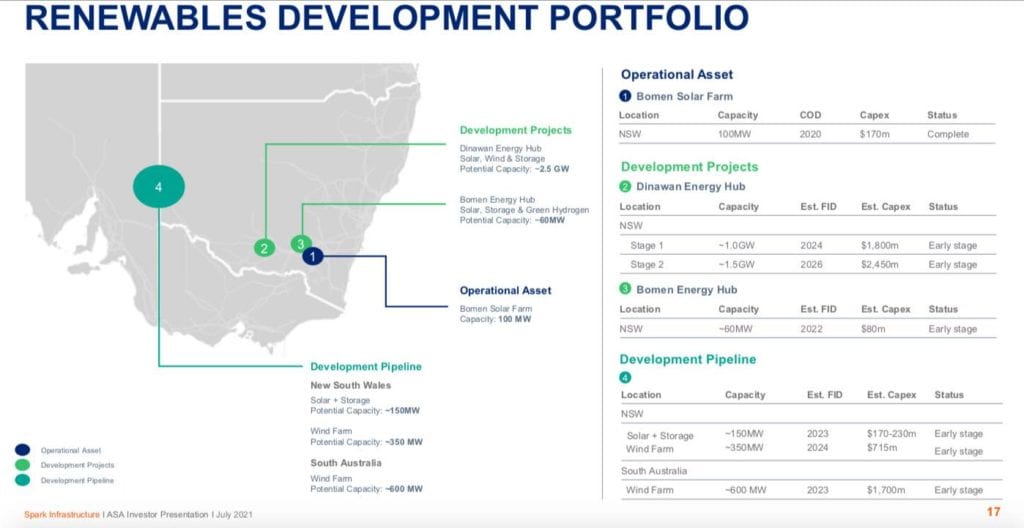Spark Renewables, part of the listed network investment company Spark Infrastructure, is proposing a massive 2.5GW wind, solar and battery storage hub in south west NSW, in the heart of a planned renewable energy zone.
The Dinawan Energy Hub and the direct investment in wind, solar and battery storage is part of a major shift into renewables and storage for the network investor, which owns half shares in local networks in Victoria and South Australia and a 15 per cent stake in NSW transmission company Transgrid.
It was unveiled just as reports emerged that Spark had become the centre of a proposed joint $5 billion bid by investment group KKR and pension fund Ontario Teachers. Spark has rejected the offer, but suggested opening a data room under certain conditions.
Spark has already made one big investment in renewables, building and owning the 100MW Bomen solar farm near Wagga Wagga (pictured above), and another offshoot, Lumea, has also recently proposed a 300MW, two hour big battery at Deer Park in Victoria, which could be the first in the country to be built without government contracts or funding.
But the proposed Dinawan hub takes the push into renewable generation to another scale.
The new hub will be located half way between Coleambally and Jerilderie and along the route of the recently committed Project EnergyConnect inter-connector, which will be built by Transgrid and ElectraNet and will run between Robertstown in South Australia and Wagga Wagga in NSW.
Spark also notes that its Dinawan hub is strategically positioned near the proposed HumeLink and VNI West (KerangLink) interconnectors, which Transgrid is also likely to build.
It’s part of a major push by Spark Renewables into the generation and storage game. It expects to build 1GW of wind, solar and battery storage in the first phase of the 2.5GW Dinawan hub, but it also has another 1.2GW of wind, solar and storage projects outside the hub.
This includes a 60MW extension to the Bomen solar farm, with some storage and potentially a green hydrogen facility, and three different but unidentified wind, solar and battery storage investments in southern NSW and South Australia.
These include a 150MW solar and battery facility in NSW, a 350MW wind farm in NSW, and a 600MW wind farm in South Australia.
Renewables and storage and the development of “unregulated” assets formed the centrepiece of a Spark investor presentation on Thursday rebutting the KKR and Ontario Teachers big.
The head of Spark Renewables, Anthony Marriner says the Dinawan hub rollout will be designed, and timed, to take advantage of new transmissions line and the planned closure of many of the state’s coal fired power stations.
Marriner is going to try and convince the NSW government to fast-track the opening of the south west renewable energy zone, because it will offer geographic diversity from the planned first stages which are focused on the central west and New England.
“This will unlock significant renewable generation capacity consisting of wind, solar and battery energy storage across South-West NSW in the coming years, providing resource diversity to renewable generation planned in the other REZ’s,” he says.
Marriner insists that Spark Renewables will not crowd out other renewables developers or mean it will have a favoured position because of its relationship with Spark and its 15% ownership of Transgrid, and he says he is keen to hear from other developers to see if their projects can form part of their plans.
“We deliberately focused on early stage projects rather than late stage, given some of the prices being paid for those,” Marriner told RenewEconomy. “We see more value in the early stage.”
He is particularly interested in working with other players in the battery storage space, such as with Neoen and its proposed massive Goyder South Energy Hub at the other end of the new transmission line, and cites the possibility of using battery storage as “virtual transmission”.
This could also apply on the VNI West and Hume transmission links.
Marriner told RenewEconomy that Spark Renewables was not interested in peaking gas generators – “we’ll leave that to others” – and said additional pumped hydro was not needed in that region give the proposed Snowy 2.0 project was “just around the corner.”
Marriner says work on preliminary studies and consultation on the Dinawan hub would start in coming months, and it would be built in stages, with the first operations to commence in 2025, after the completion of Project EnergyConnect.
“The project must undergo a rigorous planning and assessment process which includes preliminary and detailed environmental studies and extensive community consultation,” Marriner said.
“We are only at the start of the development process and are committed to working with the community and other stakeholders to identify the possible environmental, economic and social impacts and opportunities of what we’re proposing and any required mitigation measures.”
Spark says land in the area is “flat, relatively remote and expansive”, and will allow for flexibility in wind and solar farm design based on community feedback
It plans a large community fund, and expects 1,000 construction jobs and between 50 and 100 ongoing jobs. It says the project will support agriculture by diversifying farmers’ incomes and incorporating grazing across the project.












